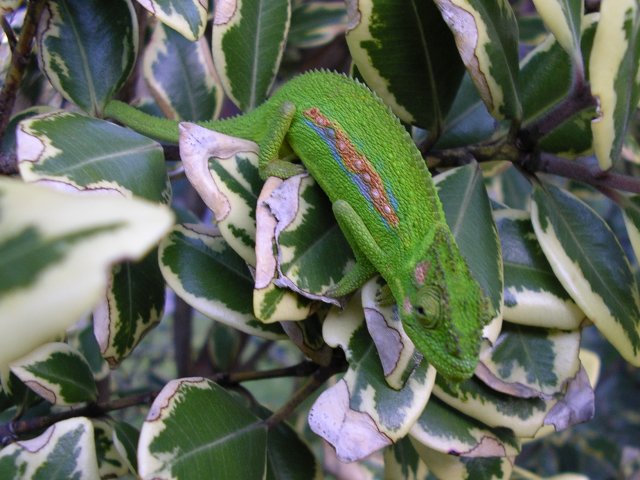Cape Dwarf Chameleon (Bradypodion pumilum) - Wiki Cape Dwarf Chameleon
From Wikipedia, the free encyclopedia
Order: Squamata
Suborder: Iguania
Family: Chamaeleonidae
Subfamily: Chamaeleoninae
[Photo] Cape Dwarf Chameleon (Bradypodion pumilum). Author: Michael Wood Taken in my garden in Kenilworth, Cape Town, South Africa. Date: 14 October 2005. Public domain by the author.
The Cape Dwarf Chameleon (Bradypodion pumilum), is a chameleon native to the South African province of the Western Cape where it is restricted to the region around Cape Town. As with most chameleons, its tongue is twice the length of its body and it can be shot out of its mouth using a special muscle in the jaw. This gives the chameleon the ability to catch insects some distance away.
Taxonomy
In the past most South African dwarf chameleons were considered to be a subspecies of the Cape species. This is now known to be wrong however; B. pumilum does not appear to have any particularly close living relatives. Like the Knysa Dwarf Chameleon it seems to be a basal offshoot of the ancestral stock which gave rise to all Bradypodion.
Endangered status
The Cape Dwarf Chameleon is an CITES-protected endangered species.
Description
The Cape Dwarf Chameleon is known to grow over 15cm in length, including the tail, with males and females reaching similar adult sizes. They are ovoviviparous, but examination in controlled captivity has shown that there is a very soft egg-like membrane around the young which is discarded immediately on birth. The young resemble miniature versions of the adults with muted colours, and typically reach no more than 2cm in length at birth. Adults can vary quite significantly in colour variety, saturation and pattern, some appearing much more vibrant than others. The tail is prehensile, and the feet are well evolved to grasping twigs, with minute claws on the end which improve their grip.
Normally very slow moving, chameleons have a characteristic shake which may let them look more like leaves to prey and predators. When provoked, they can speed up to several centimetres a second. When further provoked, they will inflate themselves, hiss, change colour dramatically and bite. They do not have sharp teeth, so their bite rarely inflicts more than a slight pinch.
Chameleons in captivity
While it is not normally legal to keep these chameleons, it is possible to obtain special permission from the South African government to do so. These chameleons are better admired than handled, although taming is possible provided a very gentle and consistent (almost daily) contact and trust is built up. This is typically achieved through careful and slow hand-based feeding of flies, small spiders, grasshoppers, etc. They cannot survive outside of their natural environment and should remain outdoors where they are able to regulate body temperature using sunlight.
http://en.wikipedia.org/wiki/Cape_Dwarf_Chameleon
| The text in this page is based on the copyrighted Wikipedia article shown in above URL. It is used under the GNU Free Documentation License. You may redistribute it, verbatim or modified, providing that you comply with the terms of the GFDL. |
